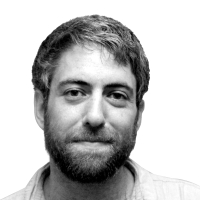AL SHAJAYA, Gaza — There is very little left of what used to be a lively and densely populated neighborhood near the border between Gaza and Israel. Many of its people ran away on Sunday as Israeli troops advanced. Others—almost 1,000 of them, almost all of them Muslims—have crowded into Gaza City’s only Greek Orthodox Church, hoping that it will not become a target. Others lie dead, or, worse, or not yet dead beneath the rubble.
Palestinian fighters waging a hit-and-run campaign have done everything they could to make Al Shajaya a battleground where the Israelis will have to pay in blood for every inch that they advance, and the Israelis are hitting back with a vengeance.
For a brief moment today, the International Committee of the Red Cross (ICRC) thought it had negotiated a local ceasefire that would allow it to search for people who were trapped and wounded, and a handful of journalists were allowed to accompany the rescue workers.
As we advanced through the devastated streets among demolished buildings, bullets cut through the air, but a trickle of people, too exhausted and afraid to take heed of this danger, advanced toward us out of the wreckage.

As we get closer to the front line, we saw bombs and artillery shells had flattened apartment buildings and shops. Blown-out walls of homes left destroyed living rooms exposed to the street, and the smell of explosives hovered in the air. Among the downed power lines and uprooted trees, the belongings of the families who had lived there were strewn about the streets with a frightening randomness. Here, on a pile of rubble next to a home with its front wall demolished, rested a woman’s black shoe. Just one. Next to it, a car was perforated with bullet holes like a makeshift sieve. There were no other signs of life on the street.
The Palestinian fighters led by the Al Qassam Brigades of Hamas have shocked the Israeli military with their stiff resistance in the district, inflicting much heavier casualties than the Israel Defense Forces have suffered in previous Gaza incursions. But it is not just the Palestinian fighters, it is the whole neighborhood that must pay the price. Now Israel is promising to expand its ground incursion in what it calls a second phase of its operation. Already, over 650 Palestinians and 35 Israelis have been killed in Gaza in 16 days of conflict. And while most Palestinian casualties have been civilian, according to the United Nations, 33 of Israel’s casualties have been military.
As a result, the temporary truce negotiated by the ICRC is uneasy and, at best, only partial. Kalashnikov fire warns us not to go any further as we reach the middle of Al Shajaya and the rescue crews quickly go to work trying to locate wounded people trapped under the collapsed homes. But their efforts suddenly are cut short when an Israeli shell screams down and levels a building one block away from where rescue crews are digging frantically through the rubble.
“There is too much fighting, we can’t get to them now,” says Larry Maybee, in charge of the ICRC’s security. He orders journalists and emergency staff to evacuate.
As we drive out without having been able to retrieve everyone, residents on the edge of the neighborhood, furious in their sense of abandonment, begin throwing rocks at the aid workers.
Some of the bystanders had come back to the edge of the district in the hope that the Red Cross’s rescue mission would give them time to collect important belongings left behind.
“I came to get my kids’ IDs and birth certificates,” said 41-year-old Tawlfek Al Mamlouk, who fled the district with his family when artillery and tank shells started landing on Saturday. Currently he is staying in a temporary shelter run by the U.N. Relief and Works Agency, which has opened its buildings to house the displaced. Still he worries about bombardment and doesn’t feel safe there after an Israeli shelling at a U.N. girls’ school on Monday.
The panicked search for someplace in Gaza that isn’t under fire has led about 1,000 people to claim refuge in Saint Porphyrios Church. “It’s for Christians so it won’t be targeted,” says Etadil al Saerky, 42, who is staying there with 12 members of her family. But, really, nowhere is safe. The church cemetery was hit with a rocket on Monday night. All that people are sure of is that a church may be a little safer than a mosque, since some 50 of those have been bombed because the Israelis believe weapons are stored in them.
Greek Orthodox Archbishop Alexios of Gaza, who has been organizing the food and shelter for those claiming refuge, refuses—despite all the suffering and fear around him—to focus only on the carnage and destruction in this latest, bloodiest Gaza war. He is determined to fulfill his mission of Christian charity, it appears, and he remains resolutely upbeat. He says a woman went into labor in the sanctuary on Monday during the shelling, and a healthy baby was delivered. “You see,” said the archbishop, “in Gaza there is also life, not only death.”






